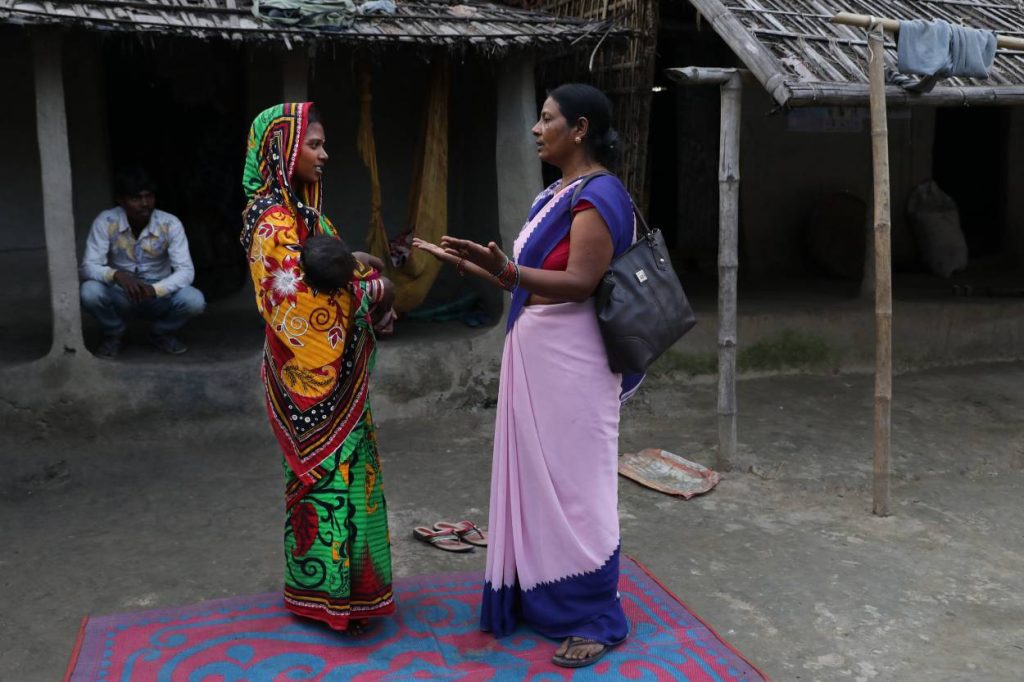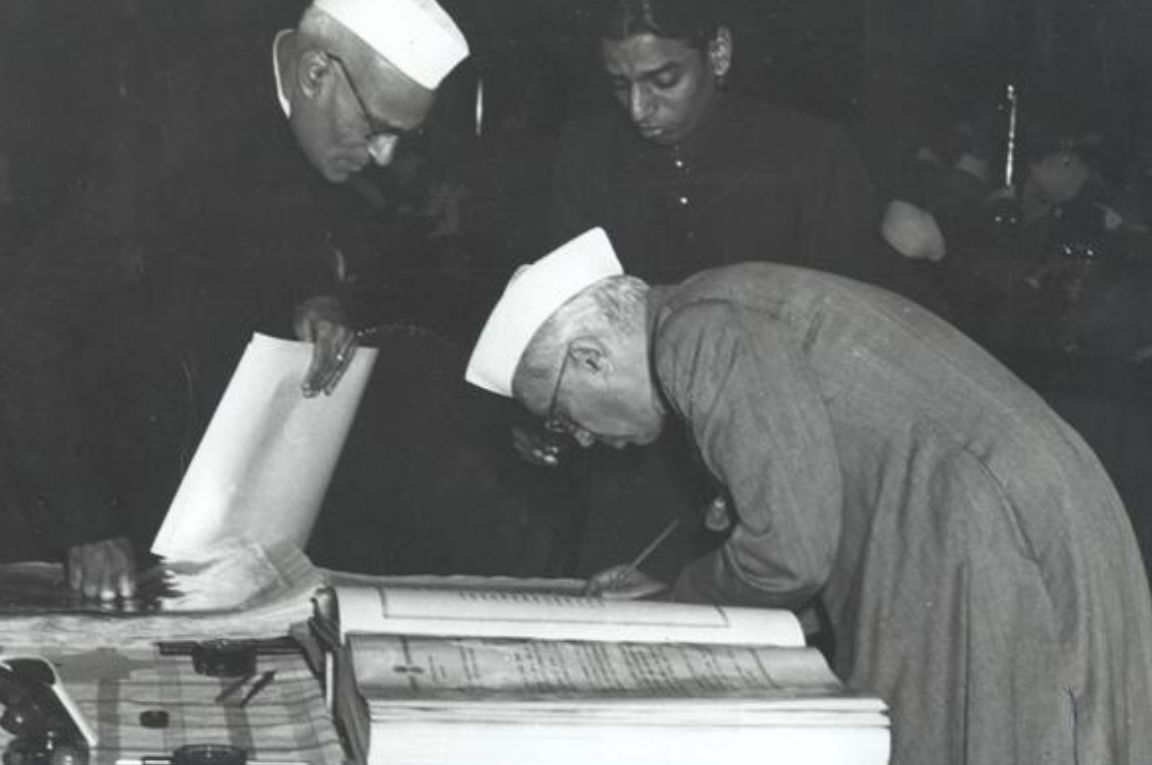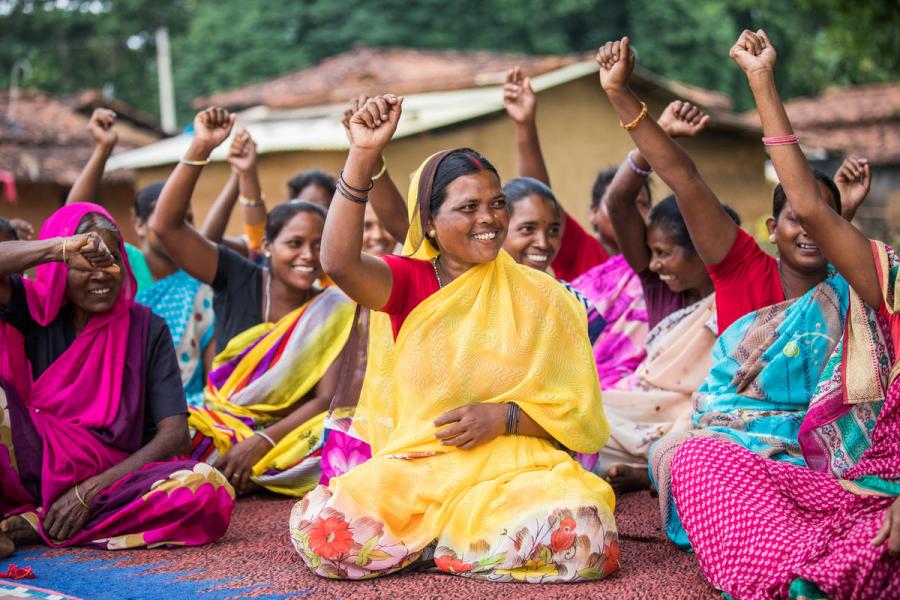Who are frontline health workers?
Frontline health workers (FLWs), also known as community health workers, are those who take health services directly to communities, where access is often limited. In India, FLWs are women who come from the communities that they are serving; they act as an essential link to health facilities by bringing services to people’s doorsteps.
India has three types of FLWs that fall within the purview of two ministries, the Ministry of Health and Family Welfare (MoHFW) and the Ministry of Women and Child Development (MoWCD):
Anganwadi worker (AWW): Anganwadi workers form a critical part of the Integrated Child Development Services (ICDS) programme, whose mandate is to provide pre-school education for children under six, and nutritional support and healthcare for children and pregnant or lactating mothers, to reduce mortality, morbidity, and malnutrition. AWWs run Anganwadi centres (AWCs)—the village- or slum-level delivery mechanism of the ICDS—and work with Accredited Social Health Activists (ASHAs) and Auxiliary Nurse Midwives (ANMs) to offer a package of six services. They fall within the purview of the MoWCD.
Accredited Social Health Activist (ASHA): ASHAs are part-time, trained community health volunteers, who work as an interface between the community and the public health system. They fall within the ambit of the MoHFW, and are a key component of the National Rural Health Mission (now called the National Health Mission). They are selected from the village to which they are accountable, and their role entails tracking pregnant women and newborns, delivering key health-related information, and promoting the better health-seeking behaviour, whether it’s in the home or at a medical institution.
Auxiliary Nurse Midwife (ANM): ANMs work at health sub-centres, which provide healthcare services at the village-level and are the closest service provider to the community, within the health system. ANMs have preliminary qualifications in midwifery and Maternal and Child Health, as well as in treating common illnesses. They provide a range of services, such as dispensing medication, immunisation and family planning, assisting with deliveries, etc.
What do FLWs do?
AWWs have varying responsibilities, from conducting regular health surveys of families and maintaining files and records to spreading awareness on health, nutrition, family planning, and child growth and development. AWWs also coordinate with block healthcare establishments and inform them of any cases of disabilities or infections among children. They are responsible for immunisation of children as well as their pre-school education.
ASHAs go door to door visiting the poorest and most vulnerable, counselling couples and pregnant women, supporting peer educators at the village level, helping with village health plans, providing medical care for minor ailments such as diarrhoea and first aid for minor injuries, and mobilising people for immunisations. They also create awareness about the various health and health-related services available to people, and encourage them to use those services. Additionally, they work with adolescents, bring married couples to primary health centres (PHCs), provide contraceptives, monitor pregnant women and accompany them to medical facilities for delivery.
ANMs, unlike AWWs and ASHAs, play a supervisory role, and participate in a range of health activities such as maternal health, child health and family planning services, nutrition and health education. They also work towards improving environmental sanitation, immunisation for communicable diseases, treating minor ailments, and offering first aid in emergencies and disasters.

Why do FLWs matter?
The neonatal mortality rate (NMR) in India is about 30, which means that out of 1,000 newborn babies in any given year, around 30 die within the first month. In 2018, India’s NMR ranks 12th from the bottom, among 52 low-middle income countries. The maternal mortality ratio (MMR) is also high at 130 per 100,000 live births. Though MMR has declined significantly—by 22% since 2013—India still accounts for 17% of all global maternal deaths.
In addition, the number of doctors vis-à-vis the size of India’s population is 0.62 per 1,000 people, compared to one doctor per 1,000 people, as prescribed by World Health Organization (WHO). This figure varies vastly across states. For many Indians living in villages, hospitals and other medical facilities are inaccessible owing to poverty, distance, and lack of knowledge, among other things. Because FLWs reside in the villages or districts they serve, they better understand the problems of the village and are trusted by the community.
The understanding, communication skills, and approach of FLWs make them arguably the most important component in any government initiative for the health of women and children. Their connect to the last mile make them crucial as an intermediary between the community and the healthcare system, especially in a culture where many women are deprived of freedom of movement. It is therefore important for policy to underscore their role, which is key to implementing sustainable changes at the local level.
When were FLWs introduced in the Indian health system?
AWWs became a part of the Indian health system in 1975, when the ICDS was launched. The ASHA cadre came about in the year 2005, whereas ANMs have been a part of the Indian public health system pretty much since the early days.
How do ASHAs, ANMs and AWWs interact?
ANMs are trained and have specialised skills, as a result of which they play a supervisory role with AWWs and ASHAs. This relationship is especially important for ASHAs, as apart from supervising their work, ANMs educate ASHAs on maternal care, pregnancy and labour. While this is how ANMs and ASHAs are supposed to interact, the extent of supervision varies widely in practice. Though these FLWs have distinct skills, roles and schedules, their responsibilities overlap. For instance, the ICDS was designed to achieve a convergence of services provided by the MoHWF and MoWCD; however, in the field there is duplication of work across the three categories.
One event that brings all of them together is the monthly Village Health Nutrition Day (VHND), when the ANM visits the Anganwadi centre, and the AWWs and ASHAs mobilise the villagers to assemble there. On the VHND, the villagers can interact freely with the health personnel, and obtain basic information and services, such as immunisation.
How many FLWs does India have?
In May 2015, India had a total of 12.96 lakh AWWs, who were running a total of 13.5 lakh AWCs. Anganwadi Helpers*, who assist AWWs numbered 11.65 lakh. Each AWW is supposed to serve a population of 1,000, and is paid around INR 4,000 per month, though this figure varies across states. Last week, Prime Minister Modi announced a hike in the remuneration to AWWs and the monthly honorarium to ASHAs.In January 2017, there were a total of 8.82 lakh ASHAs. They are supposed to serve a population of 1,000 in rural areas, and a maximum of 2,500 in urban areas. Because they’re volunteers, they do not receive a salary, but get monetary incentives for specific activities. For instance, they are paid INR 350 for every institutional delivery that happens because of them.
As for ANMs, in March 2015 India had a total of 2.12 lakh. With 155,708 functioning health sub-centres (which are supposed to serve a population of 5,000 each) and two ANMs per sub-centre, India’s total requirement for ANMs is around 47% higher than the current supply.

How much of a positive effect have they had?
Measuring the impact of FLWs is very challenging. However, we know from the experience of field workers and nonprofit programmes that they have played a crucial role in improving access to health and nutrition services. AWWs, for instance, have had a huge impact in terms of delivering food to children. Like the Mid-Day Meal scheme, ICDS has been successful in providing one meal daily to children in villages. However, whether this has improved nutrition outcomes is still a question.
According to the government’s Children of India 2018 report, institutional deliveries have doubled since 2005, since the introduction of the Janani Suraksha Yojana (JSY), which gives cash incentives for institutional deliveries (which are known to improve chances of survival for babies, than if delivered at home). ASHAs have been instrumental in mobilising women to avail of the JSY scheme.
How do the challenges and constraints they face affect their ability to do a good job?
1. Low literacy makes tasks harder: Many FLWs, especially ASHAs, come from poorer backgrounds and have difficulty reading and writing. Though their literacy levels differ widely across states, where they are low, it not only affects their ability to discharge their daily activities, but also makes them less confident to deliver new ideas in group settings. This is especially true if the ideas are unfamiliar or relate to topics like condom-use, which they may be shy to speak about openly.
2. Lack of role structure and definition confuses priorities: The work of FLWs is not always structurally defined; they can be pulled in for all kinds of government work—immunisation, polio, helping with elections, and so on. While AWWs are paid an honorarium and ANMs are paid salaries, ASHAs are paid incentives. So they lack the institutional support structure that the others get. Further, only some of their duties are incentivised, which influences their priorities.
3. Large workload and limited training impact quality: FLWs are supposed to be the go-to resource at the village level, but they may not always be equipped or sufficiently trained to handle all their responsibilities. Besides, many different kinds of responsibilities are placed on AWWs and ASHAs, such as conducting the census or undertaking additional surveys.ASHAs also need to be mobile, as they must go from house-to-house and accompany women to the hospital. Their days usually start early and they must be available at odd hours. This combined, places a tremendous burden on FLWs and their ability to execute their tasks well.
4. Community dynamics create cultural constraints: FLWs need to engage with all community stakeholders. Not only must they bring their own families on board (given their arduous work schedule), but also the families they serve, many of whom may come from upper caste backgrounds and object to interacting closely with FLWs belonging to a lower caste. Alternatively, she too may have issues about interacting with those from a lower caste. Both caste and gender also come into play when working with local leaders and community elders, many of whom are male.
How can India improve its frontline health worker system?
1. Selection: We need better selection criteria for FLWs, which go beyond their education and age. Given the nature of their work, it’s important to ensure some basic skills during recruitment, such as the ability to talk to people, the propensity to learn, and so on.
2. Training: Many of FLWs’ challenges can be solved by effective and structured training. AWWs and ASHAs don’t have a health background, making it even more important to equip them to carry out their duties. We need greater investment in both pre-service and in-service training.
3. Supportive supervision: While training is important, FLWs also need supportive supervision till the time they’re confident in their skills. Though ANMs are supposed to supervise ASHAs, in practice this remains limited largely to ANMs visiting on the Village Health and Nutrition Day.
4. Motivation: An important way to improve the FLW system is to provide the right encouragement. For ASHAs, there has been an ongoing debate around whether a fixed honorarium might be more effective than incentives. But even with incentives, there are often delays in payment, which affects motivation levels.FLWs do very essential and hard work for the health of our people, and more respect, appreciation, and community recognition might go a long way in improving the system for them and the people they serve.FLWs do very essential and hard work for the health of our people, and more respect, appreciation, and community recognition might go a long way in improving the system for them and the people they serve.
*The Anganwadi helper is a woman selected from the local community, whose primary task is to assist the AWW. She is responsible for maintaining the AWC, getting children to the centre, or any other help that the AWW might require in carrying out her duties.
With inputs and insights from Shireen Jejeebhoy and Shamik Trehan.
Saahil Kejriwal contributed to this story.





